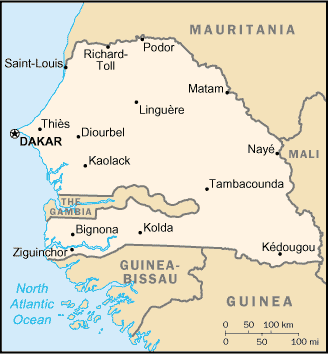Mali
I spent the first week of my vacation traveling on
over-crowded buses and cars to get from Dakar to Mali.
It was exhausting and unrewarding spending each night in a
hot and dusty town to recover from a hot and dusty day on the
road. These trips were not enhanced by the frequent breakdowns
of the dilapidated buses, which were guaranteed to stop running
every couple of hundred kilometers. The bus drivers knew their
vehicles intimately - they must be able to repair them with
minimal equipment and resources on the road, possibly in the dark.
I was especially impressed when I watched a group remove the
radiator from a bus, dig out a blister pack of superglue, then
somehow repair the offending part using only the glue and
perhaps a wrench by the light of one dying flashlight.
We were on the road again within two hours.
It is not surprising that almost everyone I met who
took buses and trains from Dakar to Bamako decided to spend
the extra money to fly back to Dakar.
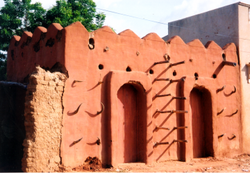
| It was not until I reached the town of Segou in Mali that
I began to feel any peace.
Segou is a beautiful and relaxed riverside town only a few hours from Bamako.
The city is full of interesting adobe buildings and
African-influenced colonial buildings.
It has pleasant hotels and reasonable restaurants, and only a
small fraction of the annoying guides that plagued Bamako and Djenne.
Unfortunately, I could not get rid of one moderately helpful guide
who followed me around during my entire day there, so I left early
the next day before he could find me.
|
| The reason that people come
to Mali is not Segou, but Djenne.
I was a little surprised that a short ferry ride across a river and
a bit of wading were required to enter the town of Djenne.
| 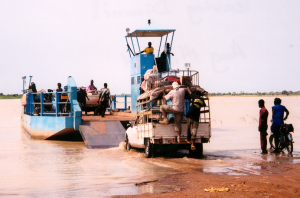
|
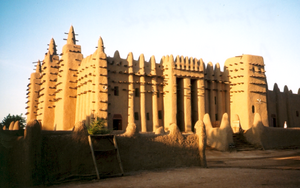
| And the mosque is the reason that people visit Djenne.
Unfortunately, non-Muslims are not permitted to enter the mosque.
I caught a glimpse of the dim interior through and open door and
wish I could have seen more.
I heard that giving the right person the right amount of money
might get you in, provided the mosque's imam approves of you.
|
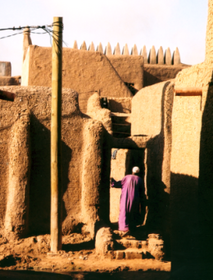
| I had assumed that this was the only attraction in the city,
but the whole town is architecturally consistent. There was hardly
a "modern" building in sight - just the work of skilled masons
using adobe bricks finished in layers of more adobe.
Many of the doors and windows were as beautiful as the buildings.
| 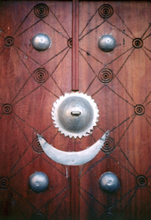
|
The main drawback to the town, which overshadows the dearth of
decent accommodation or restaurants, was the extremely persistent guides.
They constantly tried to show you their photo albums and tell you
how important it was to have a local show you around.
This made it difficult to walk or eat in peace.
Most of the guides also claimed Dogon ancestry, or at least familiarity,
and wanted to sell you expensive tours of the Dogon area.
However, after the first day, all but the most persistent guides will
give up on you because they can see that they will not get your business
and a fresh batch of new tourists arrives each day.
So if you visit Djenne, prepare to be hassled to death on the first day
but find solace in the fact that you will probably be mostly left alone
on the second. If you stay for only one day, then it might be worth
hiring a guide, even if it is just a child, so the others back off.
| The Dogon landscape looked like
a lush version of the American Southwest's.
One could sense the approach of the Sahara Desert, but there were
large numbers of baobab trees near the villages and other sorts
of trees were planted to anchor the soil.
The land near villages was completely covered in millet fields.
The geography is dominated by the Bandiagara escarpment.
| 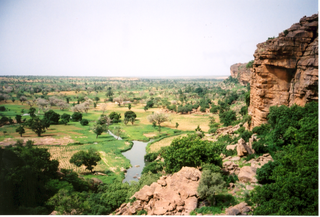
|
| Some of the Dogon villages are at the top of
the escarpment while others are in the plain below.
Begnematou is spectacularly situated on top along the cliff edge.
| 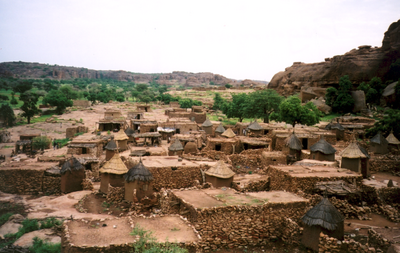
|
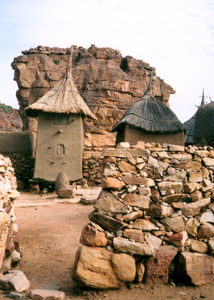
| The Dogon villages share a standard architecture and layout.
The villages were full of extended family compounds (ginnas)
enclosed by low walls.
In most cases these walls were of adobe, but the main building
material in Begnematou was rock.
The compounds included living quarters (sometimes one for each wife)
and several pointy straw-topped granaries.
The buildings and walls of richer villages had tighter masonry,
while places like Begnematou had stones of various sizes wedged together.
|
| The other major feature of each Dogon village is the toguna,
where the elders often sit and discuss matters and settle disputes.
It is a low structure of carved columns depicting figures from
Dogon mythology supporting a low thatched roof.
The ceiling is so low that one needs to sit or squat -
this posture discourages physical violence.
| 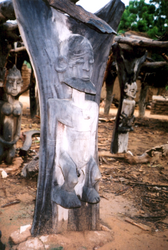
|
There were the remains of many villages on the face of the
escarpment. The ruins looked almost exactly like the currently
inhabited villages. Presumably the older and less accessible
locations were easy to defend.
The Tellem and pygmy (who were there before the Dogon)
houses appeared to be impossible to reach, even by inhabitants.
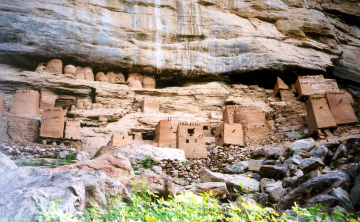
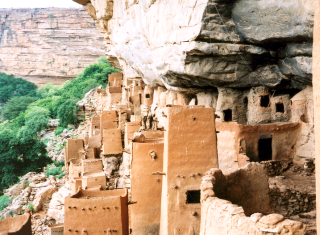
| The locks on the doors of houses and granaries were elaborately
carved. A key that looks vaguely like a toothbrush is inserted into
the right side of a sliding bolt. I never did figure out how these
worked. The doors in richer villages were of solid wood or metal and
had western-style locks.
| 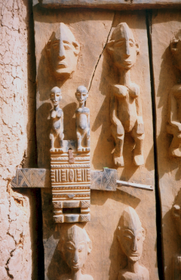
|
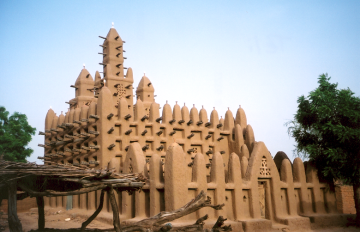
| Each village had a mosque, even though the majority of Dogons
are animist, not Muslim.
The mosques were the largest and most impressive buildings in
the Dogon area.
|
| Many (maybe even all) had churches, too, and there were even
fewer Christians than Muslims. I went to an evening service in
Nombori. While sitting in the town's guesthouse,
I heard drums and was told it was from the church.
A Christian led me to the service, which featured two drummers
(a djembe and a big talking drum) accompanying recognizable
Western hymns. The rest of the service seemed to consist of
various members asking for the congregation to pray for them.
| 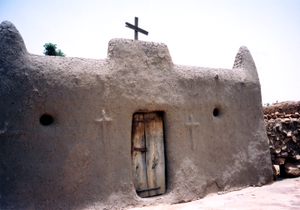
|
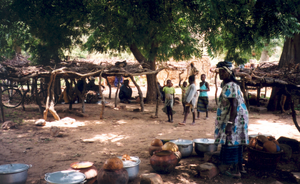
| We visited a Dogon market. Most are on 5-day cycles, which
makes it difficult for a tourist to figure out when they are in
each town. There were lots of vegetables, meat, dry goods, and
millet beer (in the pots in this photo) being sold.
The market I saw had almost nothing for tourists.
|
Senegal
Dakar is a big city that I think is better to visit at the end
of a trip to Senegal and Mali than at the beginning.
After arriving from the US, I thought it was a crowded and
dirty city with lots of thieves but no charm.
The fact that my umbrella was stolen from my bag
within half an hour of my arrival did not help my impression.
But at the end of busing around Senegal and Mali for a few weeks,
Dakar had a lot to offer.
| It is full of restaurants and hotels.
This is especially appreciated after eating nothing but
streetside brochettes of gristly meat for a couple of weeks.
If you are a coffee drinker, there are men selling Nescafe
at almost every street corner. Even if you do not think Nescafe
is real coffee, it will taste delicious at the end of weeks of
travel in the bush.
| 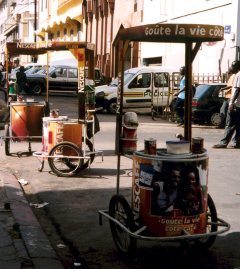
|
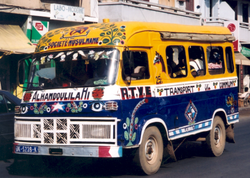
| Dakar became much easier to explore after I figured out how
to use the public transportation. Taxis could get expensive,
especially for a foreigner who is poor at negotiating fares.
I used the car rapides, which are old minibuses that
travel on fixed routes.
The cars are not labeled with their destinations, so I just
went to a stop (a stretch of street with several idling cars)
and asked for the car heading where I wanted to go. It was unbelievably
cheap - I paid between 50 and 100 CFAs (10 to 20 cents American)
per trip, which could be partway across Dakar or all the way
to the next town (Yoff or N'Gor).
|
|
There are three obvious nearby escapes from the city.
The closest is Sembedioune, a fishing village engulfed by Dakar.
The beach is full of fishing boats, and the photo shows
butcher blocks in the empty fish market.
The only problem is that an "artisanal village" is right next to
the boat launching area, so dozens of people will try to sell you
some of the worst-looking batiks and wood carvings Africa has to offer.
There are nice things also, but they require some effort to find.
| 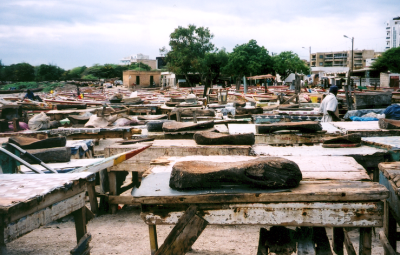
|
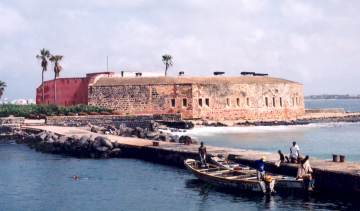
| Everyone who visits Dakar goes to Goree Island.
It is just off the coast of Dakar, and ferries constantly
shuttle tourists back and forth.
It has many beautiful colonial buildings,
but it is (in)famous for being an old slave-trading town.
It is not clear how important it was in the slave trade, but it
is a UNESCO World Heritage Site that is a pleasant escape
from the craziness of Dakar.
|
| Finally, the towns of Yoff and N'Gor seem to be popular
destinations.
They are closer to Dakar's airport than downtown Dakar,
so they can be good places to stay if you have a late flight in.
Yoff is a very conservative town where sunbathing is not common,
so N'Gor is the obvious place to go for beach fans.
The photo of N'Gor to the right is a little misleading,
since the giant hotel in the background is atypical.
The town of N'Gor consists of small, older, mostly concrete, buildings
in a maze of very narrow streets.
| 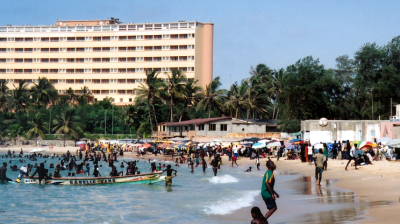
|
Links
Mali
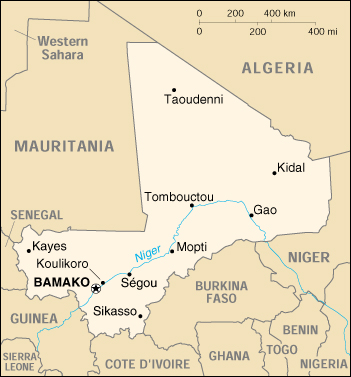
Music
Dogon
Senegal
